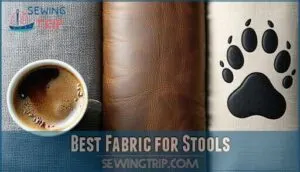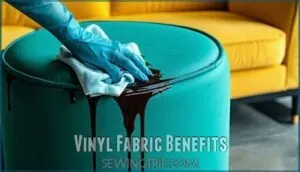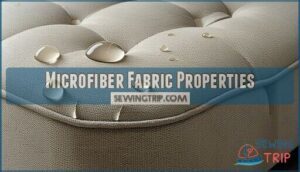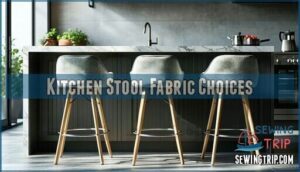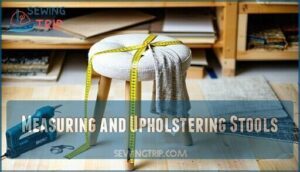This site is supported by our readers. We may earn a commission, at no cost to you, if you purchase through links.

Vinyl tops the list for kitchen and bar stools since it wipes clean easily and resists spills like a champ. If you’re after sophistication, leather brings timeless elegance but comes with a higher price tag.
For busy households with kids or pets, cotton canvas strikes the perfect balance between durability and comfort. Microfiber and polyester blends offer excellent stain resistance without breaking the bank.
The secret lies in matching your fabric choice to your lifestyle and the stool’s specific location and usage patterns, which is the key to making the right decision.
Table Of Contents
Key Takeaways
- You’ll want vinyl for kitchen and bar stools since it’s waterproof, stain-resistant, and wipes clean easily with just a damp cloth, making it perfect for high-traffic areas where spills happen frequently.
- Choose leather if you’re after sophistication and longevity – it develops a beautiful patina over time, offers natural stain resistance, and handles daily wear exceptionally well, though it comes with a higher upfront cost.
- Canvas strikes the perfect balance for busy households with kids or pets because it’s durable, breathable, machine washable, and offers excellent value without breaking your budget.
- Match your fabric choice to your lifestyle and location – consider how often you’ll use the stool, what kind of messes it’ll face, and whether you need pet-friendly options or easy maintenance features.
Choosing Fabric for Stools
When you’re picking fabric for your stool, you’ll need to think about how often you’ll use it and what kind of mess it might face.
The right fabric choice balances durability with style, so your stool looks good and holds up to daily wear, spills, and pet claws, which is crucial for daily wear.
Choose fabric that laughs at spills and scratches while making your space look amazing.
Fabric Selection Factors
When selecting the perfect fabric for stools, you’ll need to weigh several key factors that directly impact your satisfaction and investment.
The right choice balances practicality with aesthetics, ensuring your stool fabric options meet both functional needs and design preferences.
Consider these essential fabric selection factors:
- Usage Level – Heavy traffic areas demand robust materials
- Lifestyle Demands – Busy households need stain resistance and easy-to-clean surfaces
- Thread Count – Higher counts indicate superior fabric durability
- Room Decor – Fabric weight and style must complement existing aesthetics
Purpose and Traffic Considerations
Your stool’s location determines fabric choice more than you’d think.
High-traffic spots like busy kitchens need commercial stool fabric that handles spill frequency and heavy usage levels.
Residential stool fabric works fine for occasional use, but durability needs spike with traffic intensity.
To guarantee longevity, consider the fabric’s double rub rating.
Consider your lifestyle demands – will kids climb on it daily? Choose durable stool fabric accordingly.
Style and Color Matching
Beyond durability needs, your fabric choice must harmonize with existing room aesthetics.
Color palettes should complement your space’s dominant hues, while patterns require careful coordination to avoid visual chaos.
Consider these style elements:
- Material texture affects light reflection and room warmth
- Design trends influence contemporary versus classic appeal
- Color choice impacts perceived room size and mood
- Upholstery style defines formal or casual atmosphere
Pet-Friendly Fabric Options
Pets bring joy but also scratches, spills, and fur everywhere.
Microfiber’s tight weave resists claws while offering excellent stain repellency and easy cleaning with soap and water.
Leather provides scratch resistance and odor control—pet hair brushes right off.
Canvas delivers durability testing winners for busy households.
Tightly woven fabrics can also help resist claw pulls.
These petfriendly fabrics prove the best stool material combines comfort with practical fabric performance.
Best Fabric for Stools
Finding the perfect fabric for stools boils down to three champion materials that consistently outperform the competition.
Microfiber leads the pack as the best stool material, offering unbeatable stain resistance and comfort factors that make daily cleaning a breeze. Your fabric for bar stools should prioritize durability, and microfiber delivers with superior fabric lifespan at an affordable cost comparison point.
Leather takes second place in stool upholstery fabric rankings, bringing luxury and easy maintenance to your space. It’s particularly excellent for fabric for kitchen stools where spills happen frequently.
Canvas rounds out the top three, providing pet-friendly durability with impressive texture variety. Cleaning codes matter for maintaining different fabrics.
These materials handle heavy use while maintaining their appearance over time. Consider your environmental impact preferences too—synthetic options like microfiber resist wear better than natural alternatives, making them practical choices for busy households seeking long-lasting furniture solutions.
Fabric Types and Characteristics
You’ll find four main fabric types that work best for stool upholstery: vinyl, leather, canvas, and microfiber.
Each material offers different benefits, from vinyl’s waterproof protection to leather’s elegant appearance, so you can match your choice to your specific needs and budget, considering factors like waterproof protection.
Vinyl Fabric Benefits
You’ll find vinyl stands out as a champion for stool upholstery.
This vinyl stool fabric delivers exceptional vinyl durability that withstands daily wear and tear.
Its waterproof quality means spills won’t penetrate the surface, while stain resistance keeps your stools looking fresh.
You can easily clean messes with just a damp cloth.
Plus, vinyl offers impressive color versatility and cost effectiveness for any budget.
Leather Fabric Advantages
Leather upholstery transforms your stool into a sophisticated centerpiece.
You’ll appreciate leather’s exceptional durability and natural stain resistance that handles daily spills effortlessly.
This breathable material prevents uncomfortable sweating during long sitting sessions.
While leather costs more upfront, proper maintenance keeps it looking luxurious for years.
Genuine leather develops beautiful patina over time, making your investment worthwhile, and its natural stain resistance handles daily spills effortlessly.
Canvas Fabric Features
Canvas brings tough-as-nails durability to your stool upholstery without breaking the bank.
This cotton-based fabric laughs at daily wear and tear while offering impressive stain resistance. You’ll love how easy canvas is to clean – most spills wipe away with a damp cloth.
Canvas aesthetics blend seamlessly with casual or rustic décor, making it perfect for kitchen applications with a rustic feel.
Microfiber Fabric Properties
Microfiber’s polyester composition makes it a smart reupholstering choice for stool upholstery.
You’ll love its water repellency and impressive stain resistance that keeps spills from becoming permanent headaches.
This allergy friendly fabric combines durability with a surprising softness factor that feels great against your skin.
Microfiber stays easy to clean with just a damp cloth, making maintenance practically effortless.
Fabric Durability and Maintenance
When you’re selecting fabric for your stools, durability and maintenance should be your top priorities since these pieces face daily wear and tear.
You’ll want to focus on stain resistance, thread count, and cleaning requirements to guarantee your investment lasts for years while looking great.
Stain Resistance and Cleaning
Spills happen, but stain resistant fabric makes cleanup a breeze.
Accidents are inevitable, but the right fabric turns disasters into minor inconveniences.
For water-based accidents like wine or juice, you’ll want to mix mild detergent with distilled water and clean the entire surface to prevent water rings.
Tough stains respond well to a baking soda paste – just let it sit, then gently remove with a clean towel.
Many options are available if you want to shop for fabrics.
Colorfastness and Anti-Pilling
Quality fabrics maintain their vibrant appearance through superior colorfastness and antipilling properties.
You’ll want fabrics with excellent dye quality and fiber strength to prevent fading and those unsightly fabric pills that make stools look worn out.
Fabric quality affects stool fabric colorfastness.
Key fabric performance indicators to evaluate:
- UV Resistance – Prevents sun damage and color bleaching
- Wash Durability – Maintains appearance after repeated cleaning cycles
- Pilling Prevention – Keeps surface smooth and professional-looking
- Fiber Strength – Guarantees long-lasting fabric aesthetics and durability
Fabric Thickness and Weave
Beyond color stability, fabric thickness and weave density directly impact your stool’s longevity.
Thicker fabrics with tight weave construction offer superior abrasion resistance against daily wear.
Dense weaving creates stronger upholstery fabric characteristics than loose weaves.
Woven fabrics typically outlast knit varieties due to their interlocked structure.
Layered fabrics provide extra durability, while fabric weight indicates overall strength and resilience.
Fabric weight, measured in GSM, can substantially impact durability and drape, so consider fabric weight considerations when choosing your material.
Thread Count and Wear Resistance
Thread count acts like your fabric’s report card for durability.
Higher numbers mean tighter weaves that laugh off daily wear and tear.
You’ll want fabrics with robust thread counts for stools that see constant action.
Here’s what smart shoppers check:
- Thread Count Importance – Compare similar fabrics; higher counts win the durability game
- Weave Density Impact – Tighter weaves resist snags and stretching better
- Abrasion Resistance Tests – Industry standards reveal true wear resistance capabilities
- Fabric Longevity Factors – Thread count plus material type determines lifespan
Fabrics with higher thread counts often offer improved product durability.
Fabric Considerations by Stool Type
Different stool types need different fabric choices based on their location and how often you’ll use them.
Bar stools in busy kitchens require tough, stain-resistant materials like vinyl or canvas, while vanity stools in bedrooms can use softer fabrics like cotton or microfiber for comfort.
Bar Stool Fabric Options
Bar stools see heavy use and spills, making fabric choice critical.
Vinyl offers unbeatable durability and stain resistance for busy spaces. Leather provides style versatility but demands higher upkeep costs.
Canvas delivers solid comfort levels with easy cleaning methods. Microfiber balances fabric lifespan with affordability.
Your bar stool upholstery should match your lifestyle’s demands perfectly.
Kitchen Stool Fabric Choices
Kitchen environments demand fabrics that handle food spills like champions.
Vinyl and canvas top the list for kitchen stools, offering unmatched cleaning ease and stain resistant properties.
These family-friendly options balance practicality with affordability, making them perfect choices for busy households.
Microfiber also excels here, providing easy clean stool fabric that wipes down effortlessly after messy cooking sessions, making it a great option for busy households.
Vanity Stool Fabric Selection
Vanity stools deserve upholstery fabric that balances comfort prioritization with aesthetic harmony.
Since these pieces often grace formal settings, you can explore delicate fabrics like silk or velvet without worrying about heavy wear. However, consider cleaning challenges when makeup spills occur.
Top vanity stool fabric selection priorities:
- Soft textures for comfortable seating during grooming routines
- Elegant materials that complement bedroom or dressing room décor
- Stain resistance to handle cosmetic accidents and spills
- Easy to clean surfaces for quick maintenance
- Luxurious appearance that enhances your personal space ambiance
Counter Stool Fabric Considerations
Since counter stools handle moderate daily use, you’ll want fabrics that balance durability with comfort.
The "big three" fabrics—vinyl, leather, and canvas—work perfectly here, along with thick cotton for less busy spaces.
Your fabric selection should prioritize stain resistant fabric qualities while maintaining style versatility that complements your kitchen’s aesthetic.
| Fabric Type | Fabric Comfort | Cleaning Ease | Cost Effectiveness |
|---|---|---|---|
| Vinyl | Moderate comfort, easy wipe-down | Excellent – just use damp cloth | Budget-friendly, long-lasting |
| Leather | Premium comfort, breathable surface | Good – requires occasional conditioning | Higher cost but adds value |
| Canvas | Sturdy comfort, breathable weave | Very good – machine washable | Great value for durability |
| Thick Cotton | Soft comfort, natural feel | Good – spot clean or professional | Moderate cost, family friendliness |
The choice of fabric is crucial as it affects the overall aesthetic and functionality of the counter stools, making it essential to consider factors like comfort, cleaning ease, and cost effectiveness.
Measuring and Upholstering Stools
You’ll need to measure your stool seat carefully to calculate the right amount of fabric, with a standard 8-inch diameter seat requiring about one yard of fabric plus cording.
The upholstering process involves removing old materials, adding fresh foam for comfort, and stretching your chosen fabric tightly over the seat to create a professional-looking finish.
Calculating Fabric Requirements
Proper yardage estimation starts with measuring your stool’s seat diameter and height.
A standard size 8-inch seat needs one yard of upholstery fabric plus matching cording.
Add extra fabric for seam allowances and cushion thickness variations.
Consider pattern matching requirements and account for fabric waste during sewing.
Each additional stool requires one more yard.
Removing Old Fabric and Foam
Start your reupholstering project by carefully removing old tacks with pliers or a tack puller. Check for foam degradation and frame inspection issues while peeling away worn fabric. Clean off any adhesive residue with a scraper.
Tool selection matters—use the right implements to avoid damaging your stool’s structure during this pivotal upholstery cleaning phase. Considering the stool’s likely use, fabric durability is an important factor.
- Save those old foam pieces – they’re perfect templates for cutting new cushion foam to exact size
- Take photos before removal – you’ll thank yourself later when reassembling tricky corner sections
- Work slowly around delicate areas – rushing this step often leads to costly frame repairs
Applying New Fabric and Foam
Now you’ll attach the new foam cushion and fabric to your stool base.
Choose foam density that matches your comfort needs—firmer foam lasts longer.
Position your fabric face-down, then center the foam on top.
Avoid fabric stretching while pulling material taut around edges.
Use proper staple placement every two inches, ensuring even tension for professional upholstery results.
Tips for Perfecting Corners and Edges
Creating clean corners requires precise cutting at 45-degree angles to eliminate fabric bunching.
Pull material taut while stapling to maintain consistent tension across surfaces.
Use sharp upholstery needles and matching thread for tight seams that won’t unravel.
Trim excess bulk from corner areas, but leave enough fabric for secure attachment.
Practice these upholstery techniques on scraps first to achieve smooth curves and professional results.
Frequently Asked Questions (FAQs)
What fabric is best for stools?
You’ll want vinyl, leather, or canvas for bar stools since they’re stain-resistant and durable.
Microfiber works great too – it’s soft, easy to clean, and handles spills perfectly for everyday use.
What is the best material to cover a stool?
You’ll want vinyl, leather, or microfiber for your stool covering.
These materials resist stains, clean easily, and handle daily wear.
Vinyl’s most budget-friendly, leather adds elegance, while microfiber offers excellent durability for busy households, making microfiber a great option.
What is the most durable material for bar stools?
Tough, tested materials triumph for bar stools.
You’ll want vinyl, genuine leather, or heavy-duty canvas for maximum durability.
These fabrics resist stains, tears, and daily wear while maintaining their appearance through years of use, making them a great choice for durability.
What kind of upholstery fabric is best for chairs?
Microfiber and leather top the list for chair upholstery.
You’ll love microfiber’s stain resistance and easy cleaning, while leather offers timeless elegance and durability.
Both handle daily wear beautifully and suit most lifestyles perfectly, with timeless elegance being a key aspect of their appeal.
How much does professional stool reupholstering cost?
Professional stool reupholstering typically costs $75-$200 per stool, depending on fabric choice and complexity. You’ll pay more for leather or specialty materials, while basic vinyl keeps costs lower.
Can outdoor fabrics be used for indoor stools?
Like a chameleon adapting to any environment, outdoor fabrics work beautifully for indoor stools.
You’ll get extra durability, stain resistance, and fade protection. They’re designed to handle weather, so your kitchen spills won’t stand a chance, providing extra durability.
Whats the typical lifespan of stool fabric?
Your stool fabric’s lifespan depends on usage and material choice.
High-quality vinyl or leather can last 5-10 years with regular use, while microfiber typically lasts 3-7 years.
Cotton fabrics usually need replacing every 2-5 years, which affects the overall lifespan.
Are there eco-friendly sustainable fabric options available?
Going green doesn’t mean sacrificing style.
You’ll find fantastic eco-friendly options like organic cotton, hemp, and recycled polyester fabrics.
Linen’s naturally sustainable, while bamboo-blend materials offer durability with a smaller environmental footprint.
Which fabrics work best in humid climates?
In humid climates, you’ll want synthetic fabrics like microfiber, vinyl, or outdoor fabrics that resist moisture and mildew.
These materials won’t absorb humidity, dry quickly, and maintain their appearance despite constant dampness.
Conclusion
Like choosing the right foundation for a house, selecting what’s the best fabric for stools requires careful consideration of your specific needs.
You’ve learned that vinyl excels in high-traffic areas, leather adds sophistication, and canvas balances durability with comfort.
Remember to factor in your household’s lifestyle, cleaning preferences, and budget.
Whether you’re covering bar stools or vanity seats, the perfect fabric exists for your situation.
Make your choice confidently—your stools will thank you.

